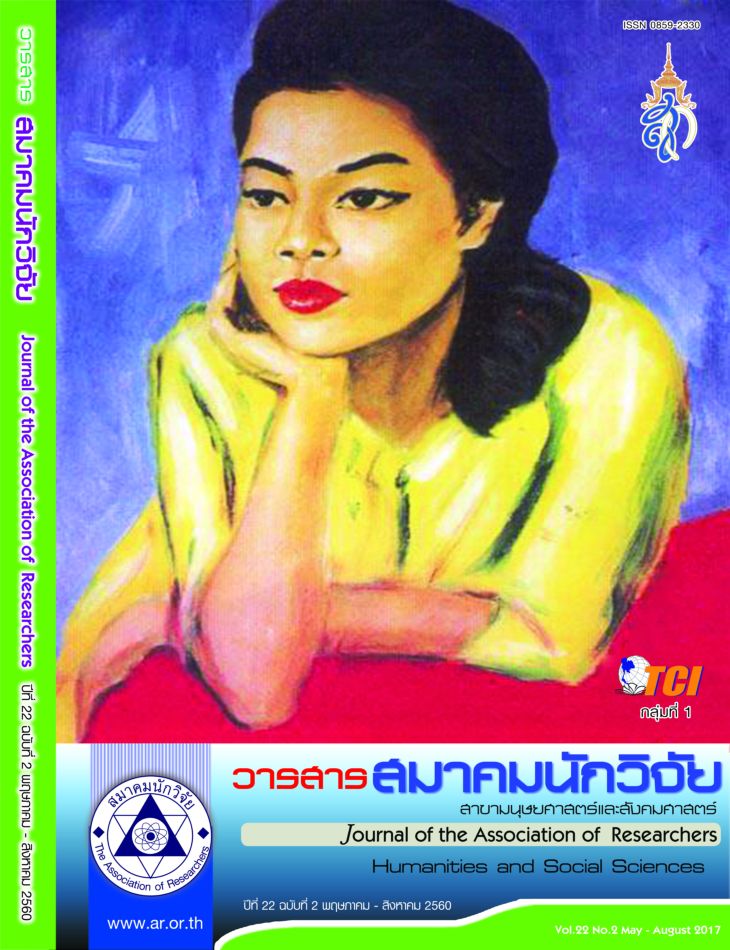Hygroscopic Properties of Fine Particulate Matter on Sub-Urban Upper Northern Thailand
Main Article Content
Abstract
This study investigated the hygroscopic properties of fine particulate matter. The samples analyzed byusing H-TDMA (HygroscopicTandem Differential Mobility Analyzer).Thehygroscopic growth rate of particles are recorded in the form of size under dry and humid condition. Six particle sizes are examined including 30, 50, 100, 150, 200, and 250 nm under dry condition with 29% relative humidity and under vapor-humid condition in Water Chamber with 87% relative humidity. The studied area is a locationof BanSunKong School, Mae Chan District, in ChiangRai Province. Study inthe summer during the24-26 March2559. Sampling collectionarea isopenspaceof thestudents' activities.Thesurrounding area is the commercial and heavy traffic. This study, hygroscopic growth factor distributionsof particles dispersed in the atmosphere's Gf found that particles dispersion separated into two groups: Less hygroscopic and More hygroscopic. The Gf valueof Less hygroscopic group is less than 1.01, while Gf valueof More hygroscopic is more than 1.01. The study found that the hygroscopic growth rate of fine particulate matter are in the groups of Less hygroscopic properties and water absorption rate was less because of the fine particulate matter that generated from the burning fuel.
Article Details
บทความที่ปรากฏในวารสารนี้ เป็นความรับผิดชอบของผู้เขียน ซึ่งสมาคมนักวิจัยไม่จำเป็นต้องเห็นด้วยเสมอไป การนำเสนอผลงานวิจัยและบทความในวารสารนี้ไปเผยแพร่สามารถกระทำได้ โดยระบุแหล่งอ้างอิงจาก "วารสารสมาคมนักวิจัย"
References
Chen, Y.Y. and W.W.G. Lee. (1999). Hygroscopic properties of inorganic-salt aerosol with surface-active organic compound. Chemosphere, 38: 2431-2448.
Chen, L.Y., F.T. Jeng, C.C. Chen and T.C. Hsiao. (2003). Hygroscopic behavior of atmospheric aerosol in Taipei. Atmospheric Environment, 37: 2069–2075.
Decesari, S., M.C. Facchini, E. Matta, M. Mircea, S. Fuzzi, A.R. Chughtai and D.M. Smith. (2002). Water solubleorganic compounds formed byoxidationof soot. AtmosphericEnvironment,36:1827-1832.
Eleftheriadisa, K., I. Colbeckb, C. Housiadasa, M. Lazaridisc, N. Mihalopoulosd, C. Mitsakoua, J. Smolike and V. Zdimale. (2006). Size distribution, composition and originof the submicron aerosol inthe marine boundarylayer duringtheeastern Mediterranean‘‘SUB-AERO’’experiment. Atmos. Environ,40: 6245-6260.
Lohmann, U. and J. Feichter. (2005). Global indirect aerosol effects: a review. Atmos. Chem. Phys, 5:715-737.
Massling A., A. Wiedensohler,B.Busch, C. Neususs and P. Quinn. (2003). Hygroscopic propertiesof differentaerosol types over the Atlantic and Indian Oceans. Atmos. Chem. Phys, 3: 1377–1397.
Massling A., M. Stock, B. Wehner, Z.J. Wu, M. Hu, E. Bruggemann, T. Gnauk, H. Herrmann and A.Wiedensohler. (2009). Size segregated water uptake of the urban submicrometer aerosol in Beijing. Atmospheric Environment, 43: 1578–1589.
Meier, J.,B.Wehner, A. Massling, W.Birmili, A. Nowak,T. Gnauk, E.Br¨uggemann, H. Herrmann, H. Minand A. (2009). Wiedensohler. Hygroscopic growth of urban aerosol particles in Beijing (China) during wintertime:acomparisonof threeexperimental methods. Atmos. Chem. Phys, 9:6865–6880.
Raes,F.,R.Van Dingenen,E.Vignati, J. Wilson, J.P.Putaud, J.H.Seinfeld and P. Adams. (2000). Formation and cycling of aerosols in the global troposphere. Atmos. Environ, 34: 4215–4240.
Sumner, G. (1988). Precipitation Process and Analysis. The Bath Press Bath, Great Britain.Svenningsson, B., H.C. Hansson, A. Wiedensohler, K. Noone. and J.
Ogren. (1994). Hygroscopic growth of aerosol-particles and its influence on nucleation scavenging in-cloud-experimental results fromKleiner-Feldberg. J. Atmos. Chem, 19: 129–152.
Svenningsson., B., H.C. Hansson, B. Martinsson, A. Wiedensohler, E. Swiwtlicki, S.I. Cederfelt, K.N. Bower,T.W. Choularton and R.N. Colvile. (1997). Cloud droplet nucleation scavengingin relation to the size and hygroscopic behavior of aerosol particles. Atmos. Environ, 16: 2463-2475.
Swietlicki, E., J. Zhou, O.H. Berg, B.G. Martinsson, G. Frank, S.I. Cederfelt, U. Dusek, A. Berner, W. Birmili, A.Wiedensohler, B. Yuskiewicz and K.N. Bower. (1999). A closure study of sub-micrometer aerosol particle hygroscopic behavior. Atmospheric Research, 50: 205–240.
Tan, H., Y. Yin, X. Gu, F. Li, P.W. Chan, H. Xu, X. Deng, and Q. Wan. (2013). An observational study of the hygroscopic propertiesof aerosolsover thePearlRiver Delta region. Atmospheric Environment, 77:817-826.
Ye., M. Stock and A. Wiedensohler. (2005). Diurnal, weekly, andseasonal variation of hygroscopic properties of
submicrometer urban aerosol particles. Atmospheric Environment, 39: 3911–3922
Ye., M. Stock, B. Wehner, Z.J. Wu, M. Hu, E. Bruggemann, T. Gnauk, H. Herrmann and A. Wiedensohler.(2009). Size segregated water uptake of the urban submicrometer aerosol in Beijing. Atmospheric Environment, 43: 1578–1589.
Ye, X., Z. Ma, D. Hu, X. Yang and J. Chen. (2011). Size-resolved hygroscopicity of submicrometer urban aerosols in Shanghai during wintertime. Atmospheric Research, 99: 353–364.
Zhenxing, S., S. Junji and C. Richad. (2009). Ionic composition of TSP and PM2.5 during dust storms and air pollution episodes at Xi’an China. Atmospheric Environment, 43: 2911-2918.


